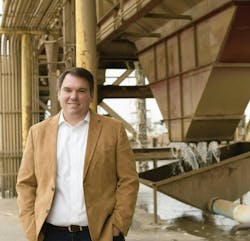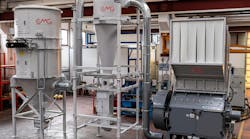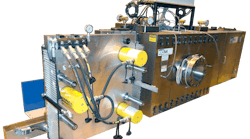From the Spring 2024 issue of Plastics Recycling.
By DeAnne Toto
Sean Whiteley doesn’t have a degree in polymer science or chemistry, but he does have a passion for the circular solutions provided by Arkansas-based recycler and plastic product producer Revolution.
Prior to becoming CEO of the company, Whiteley worked in the investment and private equity sector, giving him some exposure to the plastics industry. He was introduced to Revolution more than a dozen years ago through a consulting assignment. “I fell in love with the circular solutions that they were pioneering in the industry and the way that they were thinking holistically about plastic production, plastic recovery and plastic reuse,” he says.
Whiteley joined the business as CEO full time in 2012. “I could see the potential of the business model around circular solutions, circularity, environmental sustainability, greenhouse gas emissions reduction, landfill diversion and water conservation,” he says.
Whiteley recognized that Revolution had all the tools to address some of the challenges the plastics industry faces, though he noted some needed to be developed further.
While he says he’s played a small part in the company’s success, Revolution has been able to refine and build its product and service offering with the help of additional resources and skilled people who share Whiteley’s passion. “That’s really what’s been so instrumental in our businesses; we have found people who love the circularity model and applying that model to the challenges that they see across our industry,” he says.
In the following interview, which has been edited for clarity and conciseness, Whiteley shares his perspectives on plastics recycling and the opportunities and challenges facing the sector.
Q: How have you seen plastics recycling change over the years?
A: Fortunately, its profile has been elevated and there are many more conversations around the need for end-of-life plastic solutions and, in particular, the need for postconsumer recycled content in the new materials we are making—whether it’s the packaging space, the agricultural space, the logistics and transportation space, the medical space, food and consumer goods. There’s a growing sense and a coalescence around circular solutions that meet these needs. So, the conversation is much better than it was 12 years ago; you didn’t really hear much about it in many sectors, but now it is in every sector, including our consumer sector, our agricultural sector, our commercial sector and even in stretch film, which is a relatively new business for us. The concept of circularity has been pushed to the forefront, so that’s No. 1.
No. 2, with that conversation, there are also smart people interested in the space, which brings innovation and new equipment, new processes, new ways of thinking about how we solve the challenge of plastic after its initial useful life.
We view plastic as a renewable resource. We think plastic, if collected, recycled and remanufactured appropriately, can be a really powerful sustainable resource for our economy and for our communities.
Q: What lessons have you learned about the industry that have helped you throughout the years?
A: It is hard. What we do is very difficult. Because of that difficulty, we’ve seen a lot of good companies with good intentions and good ambitions come into the market and fail. It takes a thoughtful, determined approach. It takes real rigor behind the work that you do to create the right model to allow for continued longevity in this space.
But, if you can figure that out and tackle the three legs of the stool—that collection element, that washing, processing and recycling element and then new product production—you can develop powerful solutions for your constituents, for your customers, for your communities and for your employees.
Q: Where do you see upcoming opportunities for plastics recycling? What about challenges?
A: The market is developing in terms of equipment and technology and the enthusiasm behind recycling. We try to tackle the very dirtiest plastic material, the material that is hardest to recycle, and there are real solutions out there. I think we are just at the beginning; we’re rounding first base in terms of the people and the resources dedicated to tackling this challenge. I think over the next 10 years, you will see the recycling rate improve meaningfully as more solutions come on board.
The one thing we know is there’s a massive gap between what brands and the producers of products have said they want from a recycled-content perspective and what’s available in the market. And that gap will need to be filled with expanded production and expanded operations and expanded solutions. I think this will be a golden age for recycling as new equipment, new plants, new companies come into the market or existing companies like ours expand across the markets.
A lot of the same opportunities are also the challenge. There are misconceptions and sometimes active campaigns to mislead in terms of what can be done in the market. And, in fairness, there are folks who overpromise in terms of what can be done right now. The challenge is we as an industry have to be committed to the full circularity of plastic. If we’re not, then that creates problems across our economy and across our society.
It will take us all. It takes continued innovation from recyclers and solution providers like ourselves; it will take the work of consumers to be active participants, changing some of our behaviors to accommodate these new methodologies and these new opportunities; and then also participation by brand owners and companies that are using the plastic to develop solutions that facilitate recycling. Because plastic can be recycled as long as everyone in that value chain is committed to it.
Q: What role will innovation play in addressing hard-to-recycle plastics? What form is this innovation most likely to take?
A: You need innovation across the value chain. It will take coordinated effort, and a lot of it is educating people on how to recycle and educating brand owners and companies that are using the plastic on which recycle-friendly plastics to use.
But we need to continue to innovate on the equipment side. Washing, sorting, cleaning the material, drying the sorted and processed plastic flake, extruding that flake into a resin—all those segments require continued innovation so that we can open the aperture of the types of plastic we can receive and the types of material that are easily recycled.
Q: What advice can you offer to younger plastics recyclers entering the market?
A: Be determined, be creative and be methodical in your approach. If you do those things and you stick to it and surround yourself with really talented people, you’ll have a great chance for success.
Q: Will vertical integration be a necessity for plastics recyclers in the future? How has Revolution been able to benefit from it?
A: It’s been important for us. It’s a model we embrace, but I can’t speak to others in the industry. Others may have a different viewpoint but, for us, that control and connection across the supply chain really reinforces our model, and each segment reinforces the other, so it provides real strength and connectivity for our organization.
Just the facts
Name, title: Sean Whiteley, CEO
Company, tenure: Revolution, nearly 12 years
Location: Dallas area
Years in industry: Nearly 12
Education: Bachelor’s degree in economics from Duke University and an MBA from Harvard
Website: www.revolutioncompany.com






